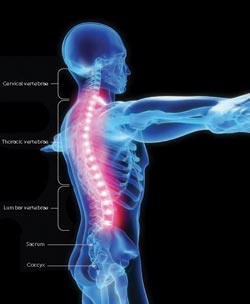Eight out of 10 Americans will suffer from back pain at some point in their lives. If you're one of them, here's what you should know.
Some days, Robert Schwartz, a writer from Ashland, Ore., has so much back pain he has to sit on the floor to put on his shoes. Although he's seen a doctor, he still doesn't know what triggers the pain or how long it will last. When it strikes, all he can do is take over-the-counter pain relievers, stretch, stay as active as possible—and avoid bending.
A Common Problem with Many Causes
Schwartz, 45, is among the estimated two-thirds of American adults who suffer from back pain—a condition almost as prevalent as the common cold. A total of 26 percent of American adults had low back pain lasting at least one whole day during the last six months, according to the most recent National Health Interview Survey, which tracks the health of the U.S. population across a broad range of topics.
For some of these people, a single episode of short-term, or acute, pain lasting from a day or two to several weeks often signals a problem that, once corrected, subsides. But for many other sufferers, back pain becomes the problem. It lingers, making it hard to get comfortable or do simple activities, like putting on shoes. This is chronic pain, like Schwartz's.


(left) Writer Robert Schwartz has chronic back pain. Photo courtesy of Robert Schwartz
(right) Dr. Rick Deyo Photo courtesy of University of Washington Medical Center
Acute or chronic, the causes of back pain are sometimes unknown.
"The most common causes are muscle sprains and changes due to arthritis of the spine—the wear-and-tear that occurs in the discs [disk-shaped pieces of tissue that serve as cushioning between the vertebrae, or bones of the spine]," says Richard Deyo, M.D., a noted back pain expert and professor of medicine and health services and attending physician at the University of Washington Medical School—Harborview Medical Center.
Dr. Deyo notes that three less common but more dramatic causes of as much as 10 percent of back pain include:
- Herniated (bulging) discs that can press on a nerve root and cause the sciatica, pain along the sciatic nerve, which runs from the lower spine down the back of the leg
- Spondylolisthesis, or slippage of one vertebra over another, resulting in narrowing of the spinal canal
- Spinal stenosis, a narrowing of the spinal canal that can pinch the nerves as they exit the spine, sometimes resulting in pain radiating down the leg
What's Behind Your Back Pain?
In most cases, back pain goes away on its own over time. But that pain can be eased by taking over-the-counter pain relievers such as aspirin, acetaminophen, or ibuprofen; using analgesic rubs; applying a heating pad or hot water bottle; and remaining active, while realizing some things will be too painful to do. "Avoiding activities that cause more pain is perfectly appropriate," says Dr. Deyo, "but bed rest is probably the wrong thing to do."
Simple techniques to help support the spine may prove helpful, too, such as placing a rolled up towel in the small of the back when sitting or driving, or putting a small pillow under or between the knees to keep the spine in a neutral position during sleep.
Chiropractic is an alternative medical system that takes a different approach from standard medicine in treating health problems. The basic concepts of chiropractic are that your body has a powerful self-healing ability, your body's structure (mainly the spine) and its function are related, and the goal of chiropractic therapy is to normalize this relationship. Doctors of chiropractic (D.C.s) use a type of hands-on therapy called spinal manipulation, or adjustment. Many people visit chiropractors for treatment of low back pain.
Research About Back Surgery
When other treatments fail, back surgery may be recommended. However, surgery's role and effectiveness in curing back pain has not been well understood. The National Institute of Arthritis and Musculoskeletal and Skin Diseases (NIAMS), part of the NIH, is seeking to bridge this gap with an ongoing clinical study, the Spine Patient Outcomes Research Trial (SPORT), a multicenter comparison of the results of surgery versus nonsurgical treatment for three of the most common reasons for back surgery. The third phase of the study will end later this year.
"The purpose is to provide physicians and patients with solid information to help them make informed decisions about how to treat their back conditions," says James N. Weinstein, D.O., M.Sc., SPORT lead author and chairman of the Departments of Orthopaedics at Dartmouth-Hitchcock Medical Center and Dartmouth Medical School.
In the study's first phase, which consisted of 472 patients with herniated lumbar disks (lower disks of the spine), researchers found that those electing surgery improved sooner than those who chose not to be operated upon.
"In general, surgery patients experienced slightly more improvement over the study period, and particularly in the first three months, than those who opted for other treatments," says Dr. Weinstein.
The second phase followed 601 patients with degenerative spondylolisthesis and symptomatic spinal stenosis. Those receiving a type of surgery called decompressive laminectomy and fusion—in which bone and soft tissue are removed to relieve pressure on the nerves and bone is grafted between the affected vertebrae—had significantly reduced pain and improved function. Those who chose non-surgical treatment improved only modestly.
Results from the third phase, which will gauge the effectiveness of surgery versus nonsurgical options for spinal stenosis without spondylolisthesis, are expected later this year.
To Find Out More
Much more information on back pain and its treatments is available at www.medlineplus.gov. Type "back pain" inside the "Search MedlinePlus" box.
While the SPORT and similar studies can help guide the surgeon and patient, ultimately the choice is up to the patient says Dr. Deyo, who participated in the SPORT study and numerous other NIH-supported back pain studies. With a few rare exceptions, back pain is not an emergency, and taking time to consider treatment options—or even wait for the pain to resolve on its own—will not lead to further harm, he says.
He cautions that even where there are clear advantages to surgery, as in spondylolisthesis, there are other reasons someone might choose not to have it. These include pain related to the surgery itself, recovery time, and the risk of complications, particularly for older patients.

